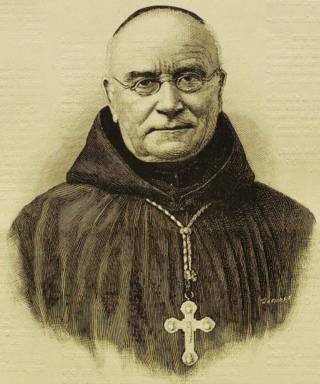
Saint-Maur-des-Fossés is a commune in Val-de-Marne, the southeastern suburbs of Paris, France. It is located 11.7 kilometres from the centre of Paris.

Odo of Cluny was the second abbot of Cluny. He enacted various reforms in the Cluniac system of France and Italy. He is venerated as a saint by the Catholic and Eastern Orthodox Churches. His feast day is 18 November.

The Tironensian Order or the Order of Tiron was a medieval monastic order named after the location of the mother abbey in the woods of Thiron-Gardais in Perche, some 35 miles west of Chartres in France). They were popularly called "Grey Monks" because of their grey robes, which their spiritual cousins, the monks of Savigny, also wore.

Maurus was the first disciple of Benedict of Nursia (512–584). He is mentioned in Gregory the Great's biography of the latter as the first oblate, offered to the monastery by his noble Roman parents as a young boy to be brought up in the monastic life.
Saint-Maur-sur-Loire is a village of western France in the département of Maine-et-Loire on the river Loire, part of the commune of Gennes-Val-de-Loire, about 15 mi (24 km) downstream from Saumur.

Fleury Abbey (Floriacum) in Saint-Benoît-sur-Loire, Loiret, France, founded in about 640, is one of the most celebrated Benedictine monasteries of Western Europe, and possesses the relics of St. Benedict of Nursia. Its site on the banks of the Loire has always made it easily accessible from Orléans, a center of culture unbroken since Roman times. In 2010, the abbey had over forty monks led by the abbot Etienne Ricaud.

The Abbey of Saint-Victor is a former abbey that was founded during the late Roman period in Marseille in the south of France, named after the local soldier saint and martyr, Victor of Marseilles.

Ligugé Abbey, formally called the Abbey of St. Martin of Ligugé, is a French Benedictine monastery in the Commune of Ligugé, located in the Department of Vienne. Dating to the 4th century, it is the site of one of the earliest monastic foundations in France. The original abbey having been destroyed during the French Revolution, the current monastic community dates from 1853, and belongs to the Solesmes Congregation.

Solesmes Abbey or St. Peter's Abbey, Solesmes is a Benedictine monastery in Solesmes, Sarthe, France, famous as the source of the restoration of Benedictine monastic life in the country under Dom Prosper Guéranger after the French Revolution. The current abbot is the Right Reverend Dom Abbot Geoffrey Kemlin, O.S.B., elected in 2022.
Odo of Glanfeuil was a ninth-century Benedictine abbot of Saint-Maur-des-Fossés, a historian, and hagiographer.

Micy Abbey or the Abbey of Saint-Mesmin, Micy, sometimes referred to as Micy, was a Benedictine abbey near Orléans at the confluence of the Loire and the Loiret, located on the territory of the present commune of Saint-Pryvé-Saint-Mesmin. Since 1939 it has hosted a community of Carmelites
Rorgon I or Rorico(n) I was the first Count of Maine and progenitor of the Rorgonid dynasty, which is named for him. He was Count of Rennes from 819 and of Maine from 832 until his death.

Louis-Charles Couturier, O.S.B., was a French Benedictine monk, Abbot of the Abbey of Saint-Pierre at Solesmes and President of the French Congregation of the Order of St. Benedict.

Bourgueil Abbey was a Benedictine monastery located at Bourgueil, historically in Anjou, currently in Indre-et-Loire and the diocese of Angers. The founder was Emma of Blois, daughter of Theobald I of Blois, and by her marriage, duchess of Aquitaine.

The Abbey of St. Mary of Lagrasse is a Romanesque abbey in Lagrasse, southern France, whose origins date to the 7th century. It is located in Languedoc, near the Corbières Massif, about 35 km from Carcassonne. It was originally a Benedictine monastery, but since 2004 has been home to a community of canons regular.
Hugh of Anzy le Duc OSB was a French Benedictine monk, who had a significant influence on monastic reform in the 9th and 10th centuries. He is also known by the name of Hugh of Autun. His birthdate is unknown. He was a native of Poitiers in France. He died in the year 930. He was a friend of Berno of Cluny, the first abbot of the Benedictine monastery at Cluny. His feastday is on April 20.

The Abbey of St. Maurice and St. Maurus of Clervaux, founded in 1890, is a Benedictine monastery in Clervaux, Luxembourg. It is a member of the Solesmes Congregation in the Benedictine Confederation.

Saint-Maur Abbey, originally called the Abbaye des Fossés, is a former abbey now subsumed in the Saint-Maur-des-Fossés suburb of Paris, France. The remains and the domain of the abbey have been transformed into a pleasure park named Parc de l'abbaye. The former abbey building has been replaced by a square at the corner of Avenue de Condé and Rue de l'Abbaye. Some ruins remain, such as the Rabelais tower, the 19th century Bourières villa and the old fortifications. The remains of the abbey have been classified as historical monuments since June 13, 1988.
Saint Mommolin of Fleury, was the second abbot of Fleury Abbey at Saint-Benoît-sur-Loire for 30 years between September 632 and January 663.














